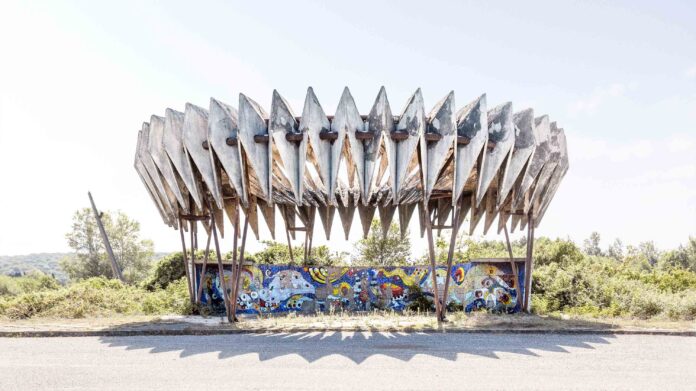Bus stop in Pitsunda, Abkhazia, Georgia.
On a long-distance bicycle trip from London to St. Petersburg in 2002, photographer Chris Herwig encountered something unexpected in the barren post-Soviet landscapes—artsy, unusual, and almost spaceship-like bus stops. The more he rode, the more he came across such unique transit structures.
As Herwig traveled through and later began living in post-Soviet states, he would keep an eye out for unusual bus stops. It fascinated him to find colorful, almost celebratory structures in a land that was once so rigidly governed.
“Wondering why they existed was one of the driving forces that had me fascinated with the bus stops,” he says. “It was totally unexpected. Every time you’d see one you’d wonder, ‘What was the plan here?’ Or, ‘What was the purpose?’ Because everything in the Soviet Union seemed regimented, planned, and organized, while the bus stops didn’t seem to have a centralized plan. In some places it was basic—the guys who were building the roads would get schoolkids to join in. It did embody the ideal of what communism was—people could contribute to the bus stops. People still paint them today, and the themes are often quite local.”
Each design is unique and shaped by the community around it. Herwig shared an anecdote about a construction worker who’d wanted to incorporate local embroidery designs into the bus stop, much to the chagrin of his colleagues.
Herwig has done a considerable amount of research, even consulting artists who were commissioned to work on the bus stops. He has yet to discover why or how it was decided that the designs should be left to local authorities. Based on his research, it seems that the bus stops were often constructed by the workers building the roads, local artists, or even community members.
On one particular trip to Armenia, Herwig had been driving for hours in a barren landscape when suddenly he saw a bus stop in the distance. “It was big, with heavy brutalist-style concrete, but at the same time really light, experimental, and fun—built to last,” he says. “It was like a spaceship [had] landed in the middle of nowhere. It’s finding them in settings like that that makes it feel really worthwhile. The architecture, landscape, and culture all come together. You’re in these flat landscapes, and boom, you see a bus stop and it’s like it’s on a pedestal, like a fantastic art installation.”
Analysis
I think it’s interesting to consider the design of bus stops from other eras and in other parts of the world, especially if I am to center my project around the design of bus stops for the Upper Arlington circulator. The idea of each bus stop being unique and designed by people from the community, as is the case with these Soviet era bus stops, is something that I think could definitely fold into social connectedness. I am also pretty intrigued by how dynamic and experimental these designs are, but I’m not sure that designs like these would be well received by Upper Arlington residents, particularly in Old Arlington where there are guidelines to keep the neighborhood aesthetic intact. However, these designs serve as a good reminder to look beyond standard bus stop design to find a solution that is more than just a bench and a simple covering.




